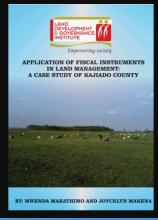/ library resources
Showing items 1 through 9 of 18.The guide focuses on equity and on how land tenure can be governed in ways that address the different needs and priorities of women and men.
New infographic by FAO and PIM on the correct use of land ownership statistics
Goal 5 of the Sustainable Development Goals (SDGs) “Achieve
gender equality and empower all women and girls” recognizesthe fundamental role of women in achieving povertyreduction, food security and nutrition.The Maghreb's oases systems provide a major contribution to the region's food security, economy and natural resources. Despite this potential, oasis ecosystems are threatened by a range of complex factors related to the expansion of agricultural land and increasing scarcity of water resources.
Fiscal instruments are tools that governments use to manage revenue and expenditure and therefore influence the growth (or stability) of the various sectors of the economy. Government revenue is derived primarily through taxation.
Land acquisitions, either driven by foreign investments or domestic investment needs have continued to polarize opinions.
Kenya is going through a period of intense transition. The country's main development policy, Vision 2030, is just entering the second Medium Term Plan of Implementation from 2013.
Kenya is currently implementing a number of large scale infrastructure and development projects aimed at trans forming the country into a newly industrializing, middle-income country.
The Land Act, 2012
The Land Registration Act, 2012
The National Land Commission Act, 2012
The Environment & Land Court Act, 2011
The Urban Areas & Cities Act, 2011
Pagination
Land Library Search
Through our robust search engine, you can search for any item of the over 73,000 highly curated resources in the Land Library.
If you would like to find an overview of what is possible, feel free to peruse the Search Guide.








